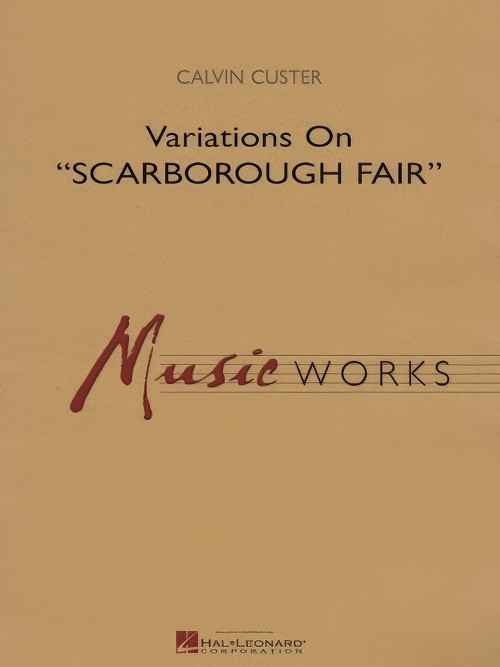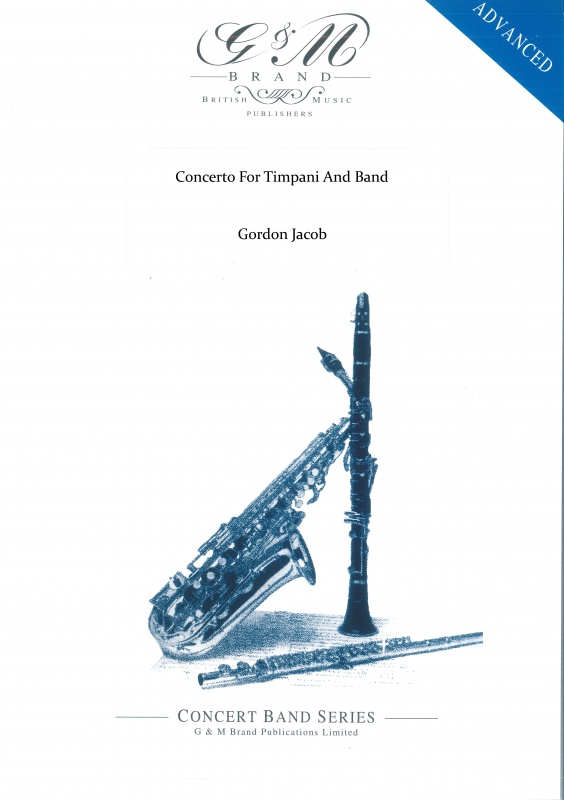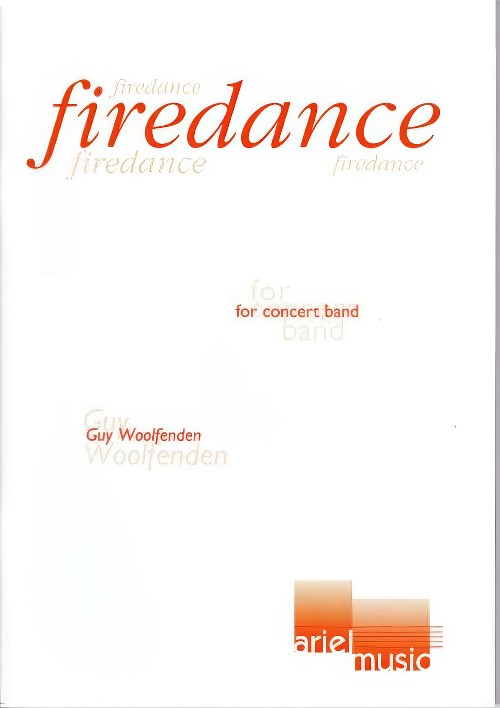Results
-
 £76.99
£76.99Scarborough Fair, Variations on (Concert Band - Score and parts) - Custer, Calvin
First published in 1989, this work from the late Calvin Custer epitomises his command of orchestration and understanding of musical pacing. The familiar folk melody is stated first by a solo flute then followed by a remarkable series of variations starting with a brass choir accompanied by woodwind flourishes. An Andante variation features the woodwind choir accompanying solos by baritone and oboe, and this leads to a striking fugue variation and bold finish. Truly symphonic band writing at its best.Duration: 4:45
Estimated dispatch 7-14 working days
-
 £104.95
£104.95Concerto For Timpani And Band (Concert Band - Score and Parts) - Jacob, Gordon
The nature of the timpani means that musical development is rhythmic rather than tonal. In the first movement, a broad theme is announced by the timpani themselves, and immediately echoed and modified by the full wind band. Material is embroidered by woodwinds and developed by the soloist. The second movement (Adagio) is virtually an aria in which we are left with an expressive mood conjured from the timpani themselves. The last movement is a romp - characteristic use of quasi-folk material is well suited to the band and the rhythmic characteristics of the timpani are highlighted.
Estimated dispatch 7-14 working days
-
 £20.95
£20.95Concerto For Timpani And Band (Concert Band - Score Only) - Jacob, Gordon
The nature of the timpani means that musical development is rhythmic rather than tonal. In the first movement, a broad theme is announced by the timpani themselves, and immediately echoed and modified by the full wind band. Material is embroidered by woodwinds and developed by the soloist. The second movement (Adagio) is virtually an aria in which we are left with an expressive mood conjured from the timpani themselves. The last movement is a romp - characteristic use of quasi-folk material is well suited to the band and the rhythmic characteristics of the timpani are highlighted.
Estimated dispatch 7-14 working days
-
 £189.95
£189.95CANYONS (Novello Symphonic) - McCabe, John
Score & Parts. Canyons is a response to the imposing landscape of the American South West, an exploration of musical ideas. The piece falls into four main sections. Following a build-up in the brass and woodwind, there is a slowish first section with massive chords, percussive pounding and some contrapuntal development of the work's main thematic idea. This is followed by a brief scherzo and then a slow movement which again derives from chordal material and another contrapuntal development. The fourth section is an extended Allegro Vivace, dominated by a dance-like theme introduced by the trumpets and an important motif heard at the start by the brass and percussion. After the final climax, the Adagio epilogue leads the music to a quiet close, the solo piccolo restating the cornet figure heard at the opening of the work. (Grade 4.5) Duration: 15 mins. Recorded on QPRM127D GUILDHALL SYMPHONIC WIND ENSEMBLE
Estimated dispatch 7-14 working days
-
 £37.95
£37.95CANYONS (Novello Symphonic) Extra Score - McCabe, John
Extra Score. Canyons is a response to the imposing landscape of the American South West, an exploration of musical ideas. The piece falls into four main sections. Following a build-up in the brass and woodwind, there is a slowish first section with massive chords, percussive pounding and some contrapuntal development of the work's main thematic idea. This is followed by a brief scherzo and then a slow movement which again derives from chordal material and another contrapuntal development. The fourth section is an extended Allegro Vivace, dominated by a dance-like theme introduced by the trumpets and an important motif heard at the start by the brass and percussion. After the final climax, the Adagio epilogue leads the music to a quiet close, the solo piccolo restating the cornet figure heard at the opening of the work. (Grade 4.5) Duration: 15 mins. Recorded on QPRM127D Great British Music for Wind Band Vol.4 (Guildhall Symphonic Wind Ensemble, Peter Gane)
Estimated dispatch 7-14 working days
-
£115.00
DIVERTIMENTO FOR BAND (Concert Band) - Woolfenden, Guy
Includes:I. ToccataII. AubadeIII. ScherzoMany of the principal musical ideas for Divertimento for Band are derived from music composed for a documentary film called Country Camera, which celebrated the work of the earliest photographers who recorded a way of life which vanished at the outset of the first World War.The three movements are played without a break. The Toccata pits a four-note motif (which always appears with its mirror image) against several other derived ideas, including a sour horn (later trumpet) figure, a tiny lyrical passage initiated by a solo alto saxophone, and a more gentle, but still staccato episode. Many polytonal devices keep the four-note motif active. The Aubade contrasts a lyrical pastorale, initiated by a solo flute, with a more intense central section on the brass. The Scherzo finale has three main ideas; a tune for principal bassoon and euphonium of a playful child-like nature, a rushing figure for the woodwinds later developed by the full band, and a solo for trumpet and clarinet, involving a descending scale and a lyrical wide-leaping recovery. The exuberant coda is derived from themes from the previous two movements.The world premiere of Divertimento for Band was given at the conference of the World Association for Symphonic Bands and Ensembles in Killarney on 13th July 2007 conducted by the composer, and is affectionately dedicated to Keith Allen, Jayne Rollason and Birmingham Symphonic Winds. -GW
Estimated dispatch 7-14 working days
-
£74.99
Feelings Wind Band Set (Score & Parts)
Feelings is a well-known easy listening hit that was written halfway through the 1970s, by the Brazilian singer-songwriter Morris Albert. However, the melody is derived from a French song (Pour toi) from 1957, written by Louis Gaste, who made this claim successfully. Over the years, Feelings has been performed by famous artists like Ella Fitzgerald, Frank Sinatra and Elvis Presley. Numerous arrangements have been made for various instrumentations. This arrangement by Roland Kernen does justice to the original. 0:04:40
Estimated dispatch 7-14 working days
-
 £115.00
£115.00FIREDANCE (Concert Band) - Woolfenden, Guy
Firedance was commissioned by Warwick Castle for one of its celebrated annual fireworks concerts at the Warwick and Leamington Festival. The first performance was given by the Philharmonia Orchestra conducted by Martyn Brabbins on July 1st 2000.Keith Allen, musical director of Birmingham Symphonic Winds, heard the piece at Warwick Castle, and commissioned a new arrangement for BSW's 10th anniversary concert on 16th November 2002 at the CBSO Centre, Birmingham, when it was conducted by the composer.Firedance starts with jagged rhythms in a minor tonality, and apart from a final accelerando, keeps the same pulse for its near ten-minute span, becoming gradually more celebratory, major-key and melodic.This new version for concert band is dedicated to all members of Birmingham Symphonic Winds with great affection. - GW
Estimated dispatch 7-14 working days
-
 £97.02
£97.02Our First Band Concert (Concert Band - Score and Parts)
(David Shaffer, James Swearingen, Robert W. Smith, Rob Grice) Stretch your budget dollars with this collection of four popular and contrasting Sound Foundations series publications! This set includes: "Starburst Fanfare" an energetic opener by David Shaffer "Heroes and Glory" a delightful overture by James Swearingen "Be Still My Soul" a beautiful lyrical arrangement by Robert W. Smith "12 The Clock Strikes" a humorous musical work by Rob Grice All 4 selections are at the grade .5 level, utilizing just the first six notes learned in band instruction, and perfect for that first semester concert!
Estimated dispatch 7-14 working days
-
 £97.02
£97.02Our First Christmas Concert! (Concert Band - Score and Parts)
Stretch your beginning band budget dollars at Christmastime with this outstanding collection of four holiday favorites! Includes four complete band arrangements in one, all grade 1.5. Includes: A CHRISTMAS CLASSIC by James Swearingen DOWN THROUGH THE CHIMNEY by Jerry Williams THE SEASON by James Swearingen A SNOWY CHRISTMAS DAY by Jerry Williams
Estimated dispatch 7-14 working days
